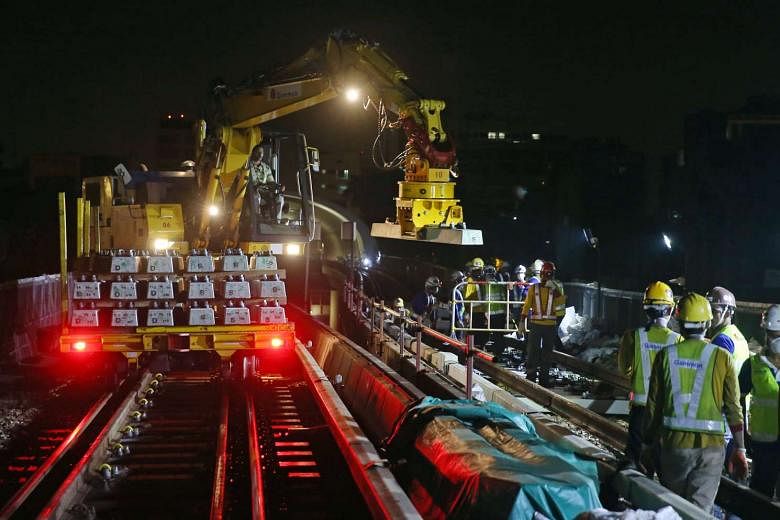A massive project to replace every timber sleeper on the North-South and East-West MRT lines (NSEWL) with hardier, concrete ones has been completed, The Sunday Times has learnt.
A total of 188,000 sleepers across the two MRT lines were upgraded over a four-year period, with rail workers installing the last concrete sleeper on the westbound tracks at Clementi MRT station last Tuesday.
Sleepers help to hold the tracks in place. Worn-out ones can mean a bumpier ride for commuters and, in extreme cases, pose a safety risk.
The project's completion marks a milestone in the renewal of the 29-year-old NSEWL and commuters can expect a smoother and more comfortable ride.
During the project, speed restrictions had to be imposed for about four- to six-week periods on sections of the tracks where sleepers were newly laid, to give them time to settle on the ballast bed.
The last of these speed restrictions is expected to be lifted early next year, so trains will return to normal speeds of up to 80kmh, instead of being capped at between 40kmh and 60kmh.
The sleeper replacement project is one of several concurrent efforts - which include upgrading the signalling, third-rail and power systems - to boost the reliability and lifespan of the island's oldest and most-used MRT lines.
Concrete sleepers have a lifespan of 50 years, more than twice that of the wooden ones.
While the replacement of the 96,000 sleepers on the North-South Line (NSL) was finished in April last year, the schedule to upgrade the 92,000 ones on the East-West Line (EWL) was nearly thrown off-track.
Due to the massive July 7 disruption last year which crippled the NSEWL and affected more than 400,000 commuters, access to the tracks for re-sleepering works was temporarily suspended so investigations could be carried out.
To make up for lost time, SMRT closed stretches of the EWL earlier to extend off-service hours, giving rail workers more time on the tracks. Certain EWL stations were also opened later on Sundays.
Besides smoother journeys, commuters can also expect trains on the NSL to arrive at shorter intervals of 100, instead of 120 seconds, in the first quarter of next year.
This is when an upgraded signalling system becomes operational, allowing each train's exact location and speed to be relayed to a computer, so trains can run closer together.
For the EWL, signalling upgrading works are more than 80 per cent complete, and the system will be operational in 2018. When the entire NSEWL moves to the new signalling system, capacity will be boosted by 20 per cent.
National University of Singapore transport researcher Lee Der Horng said the upgraded signalling system and planned addition of new trains will be key to improving the overall level of service.
Dr Park Byung Joon, a senior lecturer at SIM University, added that engineers must continue to work on the rail power system, which has been the cause of breakdowns. On April 25, the NSEWL, Circle Line and Bukit Panjang LRT were disrupted due to a power trip. With the re-sleepering done, there will be more resources available, he added.
In October, the Land Transport Authority said it was "considering upgrading to a brand new power supply system".


